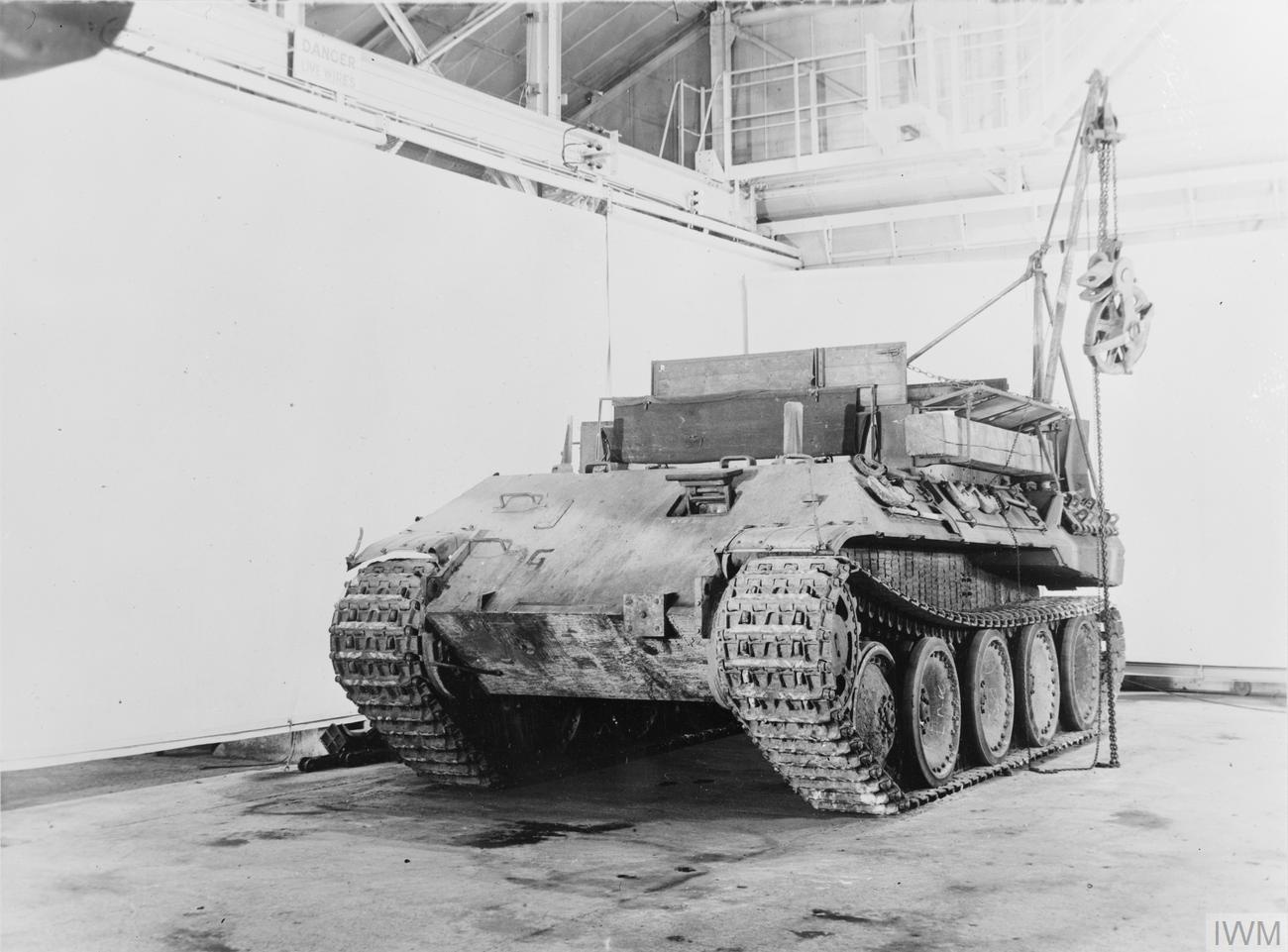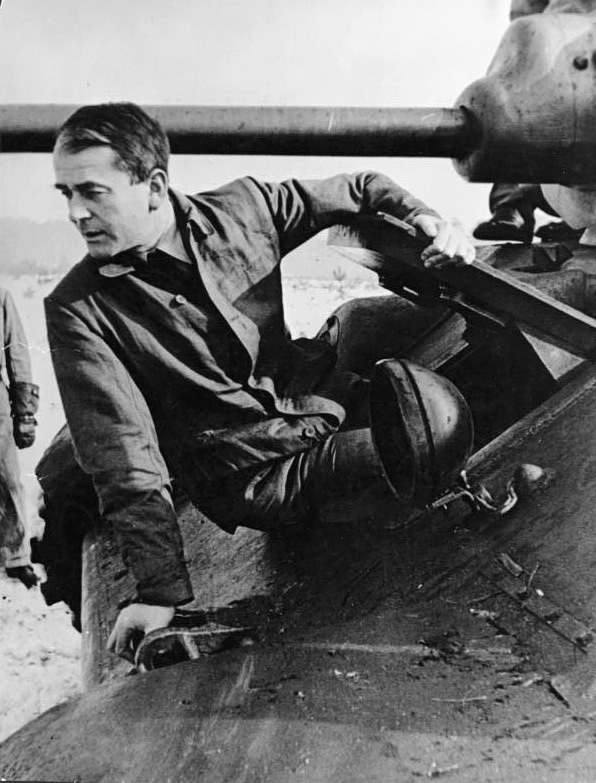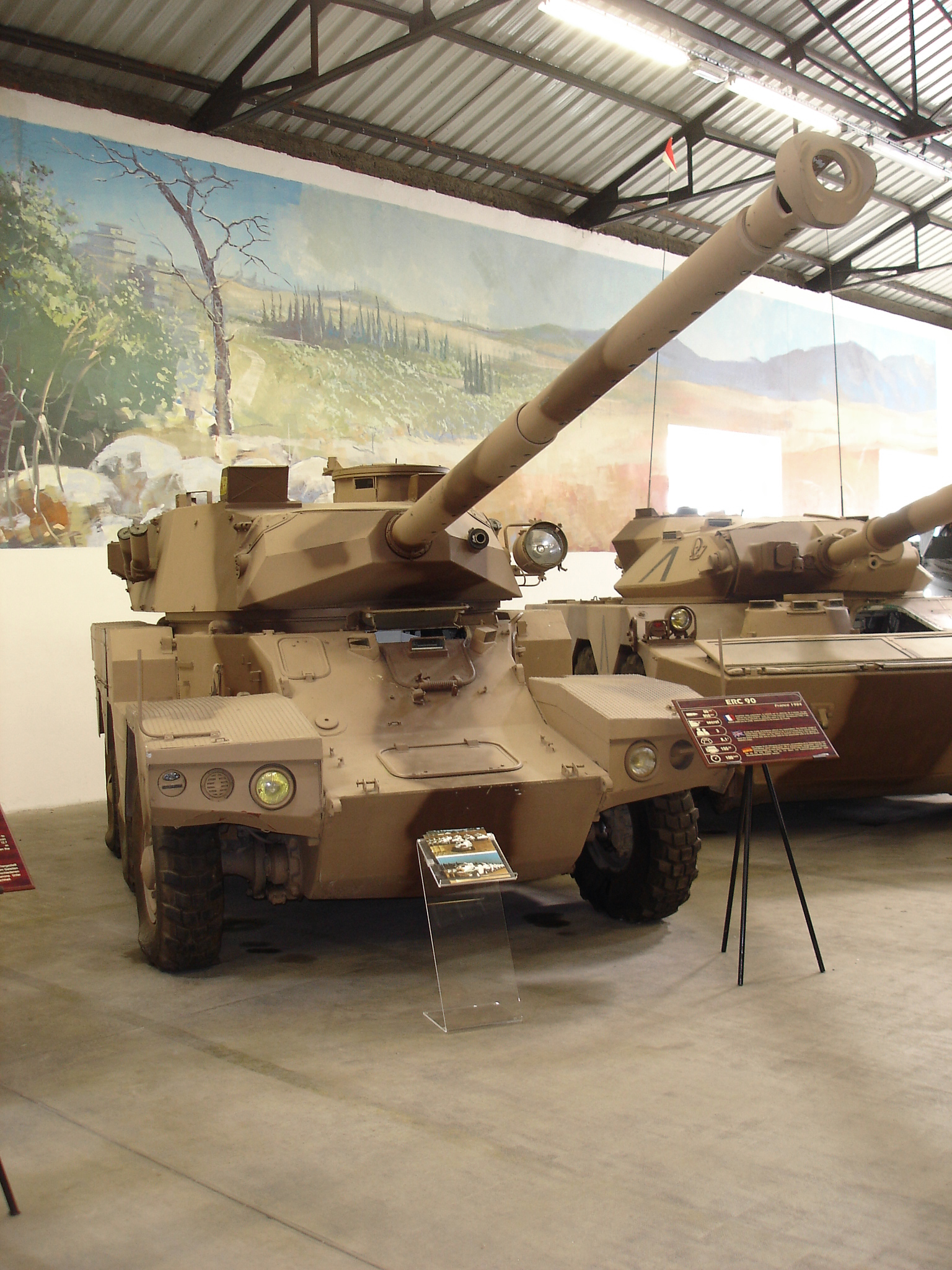|
Bergepanther
The Bergepanzerwagen V (Sd.Kfz. 179), often referred to as the "Bergepanther", was an Armoured recovery vehicle used by the German army in WWII. It was a variant of the Panzerkampfwagen V Panther (Sd.Kfz. 171). Development and production The idea of a Bergepanther came about in 1943 because of problems with the recovery of heavy and medium tanks. The development was carried out by MAN. The half-track vehicles used up to then for recovery (e.g. Sd.Kfz. 9) were rarely able to successfully recover a Panther or a Tiger; towing with another Tiger or Panther was strictly forbidden as this could lead to the loss of both tanks. The first Bergepanthers were almost completed Panthers of the Ausf. D, in which the manufacturer MAN only omitted the turret. Henschel, Daimler-Benz and DEMAG later took on the production one after the other. The specially produced hull of the Bergepanther was largely similar to that of the Panzerkampfwagen Panther, although the modifications of the Ausf. G we ... [...More Info...] [...Related Items...] OR: [Wikipedia] [Google] [Baidu] |
Panzerkampfwagen V Panther
The Panther tank, officially ''Panzerkampfwagen V Panther'' (abbreviated PzKpfw V) with Sonderkraftfahrzeug, ordnance inventory designation: ''Sd.Kfz.'' 171, is a German medium tank of World War II. It was used on the Eastern Front (World War II), Eastern and Western Front (World War II), Western Fronts from mid-1943 to the end of the war in May 1945. On 27 February 1944 it was redesignated to just ''PzKpfw Panther'', as Hitler ordered that the Roman numeral "V" be deleted. In contemporary English-language reports it is sometimes referred to as the "Mark V". The Panther was intended to counter the Soviet T-34 medium tank and to replace the Panzer III and Panzer IV. Nevertheless, it served alongside the Panzer IV and the heavier Tiger I until the end of the war. It had excellent firepower, protection and mobility, although its reliability was less impressive. The Panther was a compromise. While having essentially the same Maybach V12 petrol (690 hp) engine as the Tiger I, ... [...More Info...] [...Related Items...] OR: [Wikipedia] [Google] [Baidu] |
2 Cm KwK 30
The 2 cm KwK 30 L/55 ''(2 cm Kampfwagenkanone 30 L/55)'' was a German 2 cm cannon used as the main armament of the German Sd.Kfz.121 Panzerkampfwagen II light tank and various reconnaissance vehicles. It was used during the Spanish Civil War and the Second World War. It was produced by Mauser and Rheinmetall-Borsig from 1935. The KwK 30 also served as the basis for the 20 mm C/30, an aircraft variant mounted experimentally in some Heinkel He 112 fighters and proved to make an excellent ground-attack weapon during the Spanish Civil War. Direct ground-attack was not considered a priority for the Luftwaffe The ''Luftwaffe'' () was the aerial-warfare branch of the German ''Wehrmacht'' before and during World War II. Germany's military air arms during World War I, the ''Luftstreitkräfte'' of the Imperial Army and the '' Marine-Fliegerabtei ... and thus, the cannon was not used on other designs. An improved version, the 2 cm KwK 38 L/55 ''(2 c ... [...More Info...] [...Related Items...] OR: [Wikipedia] [Google] [Baidu] |
DEMAG
Demag Cranes AG is a German heavy equipment manufacturer now controlled by Japan-based Tadano via a $215 million deal. The roots of Demag date back prior to its formation, but became Märkische Maschinenbau-Anstalt, Ludwig A.-G in 1906 as the biggest crane building company in Germany employing 250-300 people. The company was a manufacturer of industrial cranes that included types like, bridge cranes, hoist (device), overhead cranes, Gantry crane to name a few. In 1910 came the hour of the Deutsche Maschinenfabrik in Duisburg – known worldwide by its telegram abbreviation Demag (now ''Demag Cranes & Components GmbH''). In 1973 The Mannesmann group assumed ownership of Demag. Since that time the company has continued to grow and change. Parts of the company under core business structuring moved from its ownership to focus the main concept of the company. Founding The Demag company was formed finally 1910 in Duisburg through the union of the ''Märkische Maschinenbau-Anstalt L ... [...More Info...] [...Related Items...] OR: [Wikipedia] [Google] [Baidu] |
Armoured Recovery Vehicle
An armoured recovery vehicle (ARV) is typically a powerful tank or armoured personnel carrier (APC) chassis modified for use during combat for military vehicle recovery (towing) or repair of battle-damaged, stuck, and/or inoperable armoured fighting vehicles, such as tanks and armoured personnel carriers. Most ARVs have motorized tracks, like a tank or bulldozer, enabling the ARV to operate on uneven ground. The term "Armoured Repair and Recovery Vehicle" (ARRV) is also used. ARVs may have winches, jibs, cranes, and/or bulldozer blades to aid in tank recovery. Typically, any specialized lifting and recovery equipment replaces the turret and cannon found on a battle tank. ARVs may in some cases have electric generators, blowtorches, chainsaws and fuel pumps to help with recovery operations, or spare parts, to facilitate field repairs. Some ARVs have a spade component to anchor the vehicle when it is towing or lifting. Since most ARVs are based on tank or APC chassis, they have ... [...More Info...] [...Related Items...] OR: [Wikipedia] [Google] [Baidu] |
Musée Des Blindés
The ''Musée des Blindés'' ("Museum of Armoured Vehicles") or ''Musée Général Estienne'' is a tank museum located in the Loire Valley of France, in the town of Saumur. It is now one of the world's largest tank museums. It began in 1977 under the leadership of Colonel Michel Aubry, who convinced both the French military hierarchy and the local political authorities. Started years ago with only a few hundred tracked vehicles, it has become a world-class collection which attracts visitors interested in the history of multinational tank development as well as professional armor specialists. From the very beginning, Colonel Aubry had made it a key policy of the museum to restore to running condition as many historically or technically significant vehicles as was feasible. The museum has the world's largest collection of armoured fighting vehicles and contains well over 880 vehicles, although the British Tank Museum has a larger number of tanks. Because of shortage of space, ... [...More Info...] [...Related Items...] OR: [Wikipedia] [Google] [Baidu] |
Tiger I
The Tiger I () was a German heavy tank of World War II that operated beginning in 1942 in Africa and in the Soviet Union, usually in independent heavy tank battalions. It gave the German Army its first armoured fighting vehicle that mounted the 8.8 cm KwK 36 gun (derived from the 8.8 cm Flak 36). 1,347 were built between August 1942 and August 1944. After August 1944, production of the Tiger I was phased out in favour of the Tiger II. While the Tiger I has been called an outstanding design for its time, it has also been called overengineered, using expensive materials and labour-intensive production methods. In the early period Tiger was prone to certain types of track failures and breakdowns and was in general limited in range by its high fuel consumption. It was expensive to maintain, but generally mechanically reliable. It was difficult to transport and vulnerable to immobilisation when mud, ice, and snow froze between its overlapping and interleaved ''Schacht ... [...More Info...] [...Related Items...] OR: [Wikipedia] [Google] [Baidu] |
Henschel & Son
Henschel & Son (german: Henschel und Sohn) was a German company, located in Kassel, best known during the 20th century as a maker of transportation equipment, including locomotives, trucks, buses and trolleybuses, and armoured fighting vehicles and weapons. Georg Christian Carl Henschel founded the factory in 1810 at Kassel. His son Carl Anton Henschel founded another factory in 1837. In 1848, the company began manufacturing locomotives. The factory became the largest locomotive manufacturer in Germany by the 20th century. Henschel built 10 articulated steam trucks, using Doble steam designs, for Deutsche Reichsbahn railways as delivery trucks. Several cars were built as well, one of which became Hermann Göring's staff car. In 1935 Henschel was able to upgrade its various steam locomotives to a high-speed Streamliner type with a maximum speeds of up to by the addition of a removable shell over the old steam locomotive. In 1918, Henschel began the production of gearboxes a ... [...More Info...] [...Related Items...] OR: [Wikipedia] [Google] [Baidu] |
Tonne-force
A ton-force is one of various units of force defined as the weight of one ton due to standard gravity.All calculations on this page assume the following definition of standard gravity, ''g''0. :''g''0 = The precise definition depends on the definition of ''ton'' used. Tonne-force The tonne-force (tf or tf)The tonne-force, also known as the metric ton-force, is equivalent to the megagram-force (Mgf or Mgf) and the megapond (Mp). is equal to the weight of one tonne. : Long ton-force The long ton-force is equal to the weight of one long ton. : Short ton-force The short ton-force is equal to the weight of one short ton The short ton (symbol tn) is a measurement unit equal to . It is commonly used in the United States, where it is known simply as a ton, although the term is ambiguous, the single word being variously used for short, long, and metric ton. The vari .... : Notes {{reflist, group=note Units of force ... [...More Info...] [...Related Items...] OR: [Wikipedia] [Google] [Baidu] |
Winch
A winch is a mechanical device that is used to pull in (wind up) or let out (wind out) or otherwise adjust the tension of a rope or wire rope (also called "cable" or "wire cable"). In its simplest form, it consists of a spool (or drum) attached to a hand crank. Traditionally, winches on ships accumulated wire or rope on the drum; those that do not accumulate, and instead pass on the wire/rope (see yacht photo above), are called capstans. Despite this, sailboat capstans are most often referred to as winches. Winches are the basis of such machines as tow trucks, steam shovels and elevators. More complex designs have gear assemblies and can be powered by electric, hydraulic, pneumatic or internal combustion drives. It might include a solenoid brake and/or a Mechanical brake stretch wrapper, mechanical brake or ratchet (device), ratchet and pawl which prevents it unwinding unless the pawl is retracted. The rope may be stored on the winch. When trimming a line on a sailboat, the ... [...More Info...] [...Related Items...] OR: [Wikipedia] [Google] [Baidu] |
Daimler-Benz
The Mercedes-Benz Group Aktiengesellschaft, AG (previously named Daimler-Benz, DaimlerChrysler and Daimler) is a German Multinational corporation, multinational automotive corporation headquartered in Stuttgart, Baden-Württemberg, Germany. It is one of the world's leading car manufacturers. Daimler-Benz was formed with the merger of Benz & Cie. and Daimler Motoren Gesellschaft in 1926. The company was renamed DaimlerChrysler upon acquiring the American automobile manufacturer Chrysler Corporation in 1998, and was again renamed Daimler AG upon divestment of Chrysler in 2007. In 2021, Daimler AG was the second-largest German automaker and the sixth-largest worldwide by production. In February 2022, Daimler was renamed Mercedes-Benz Group. The Mercedes-Benz Group's marques are Mercedes-Benz for cars and vans (including Mercedes-AMG and Maybach#Mercedes-Maybach, Mercedes-Maybach) and Smart (marque), Smart. It has shares in other vehicle manufactures such as Daimler Truck, Denza, BA ... [...More Info...] [...Related Items...] OR: [Wikipedia] [Google] [Baidu] |
Henschel
Henschel & Son (german: Henschel und Sohn) was a German company, located in Kassel, best known during the 20th century as a maker of transportation equipment, including locomotives, trucks, buses and trolleybuses, and armoured fighting vehicles and weapons. Georg Christian Carl Henschel founded the factory in 1810 at Kassel. His son Carl Anton Henschel founded another factory in 1837. In 1848, the company began manufacturing locomotives. The factory became the largest locomotive manufacturer in Germany by the 20th century. Henschel built 10 articulated steam trucks, using Doble steam designs, for Deutsche Reichsbahn railways as delivery trucks. Several cars were built as well, one of which became Hermann Göring's staff car. In 1935 Henschel was able to upgrade its various steam locomotives to a high-speed Streamliner type with a maximum speeds of up to by the addition of a removable shell over the old steam locomotive. In 1918, Henschel began the production of gearboxes at t ... [...More Info...] [...Related Items...] OR: [Wikipedia] [Google] [Baidu] |




.jpg)